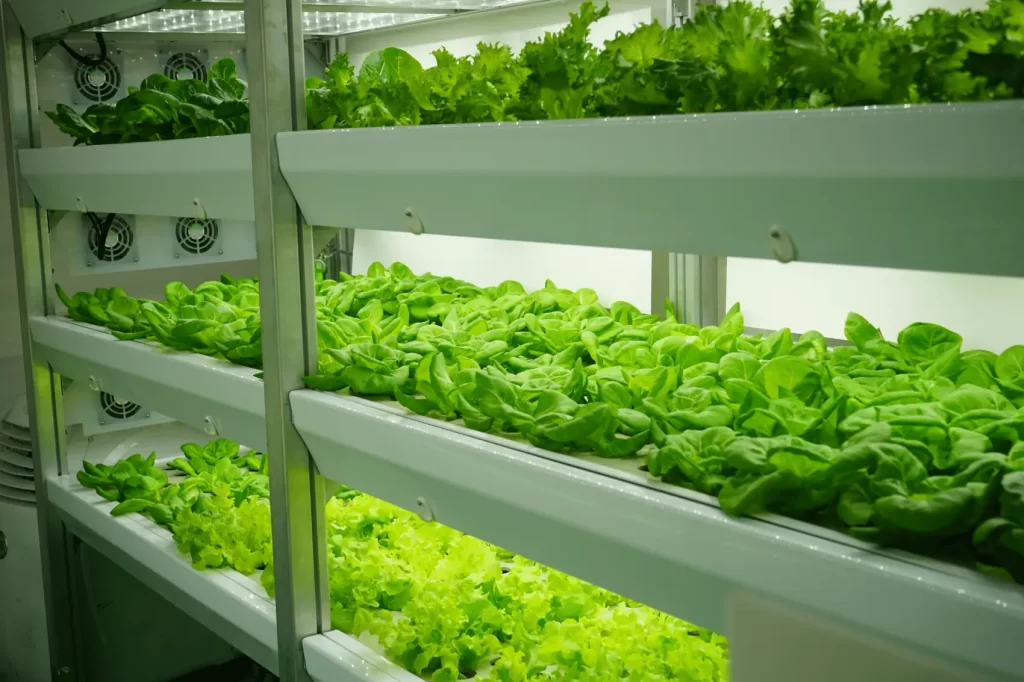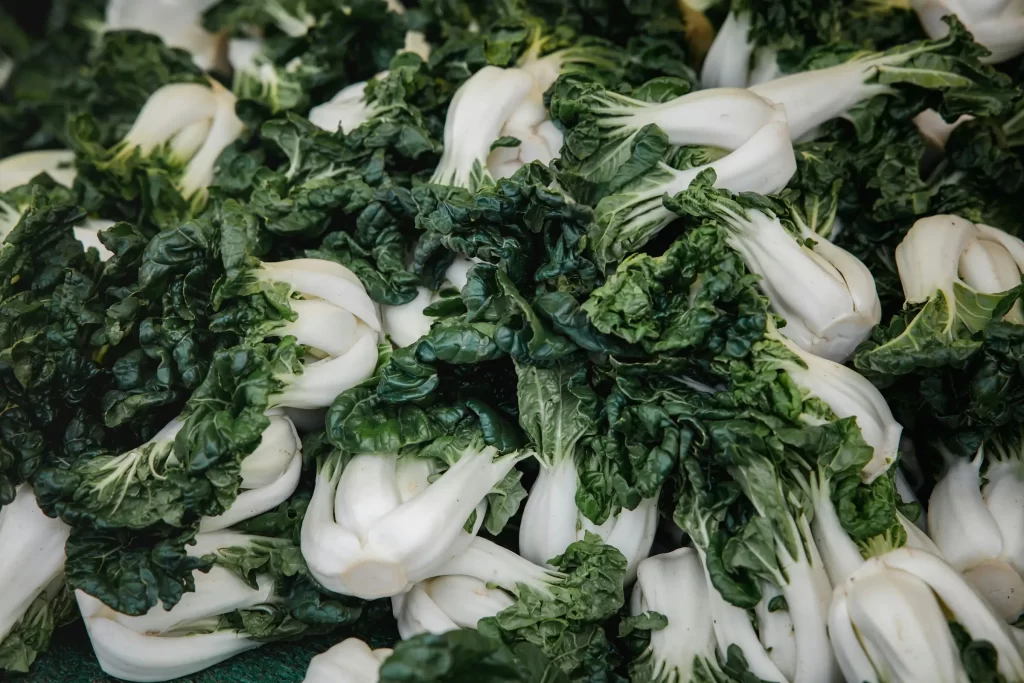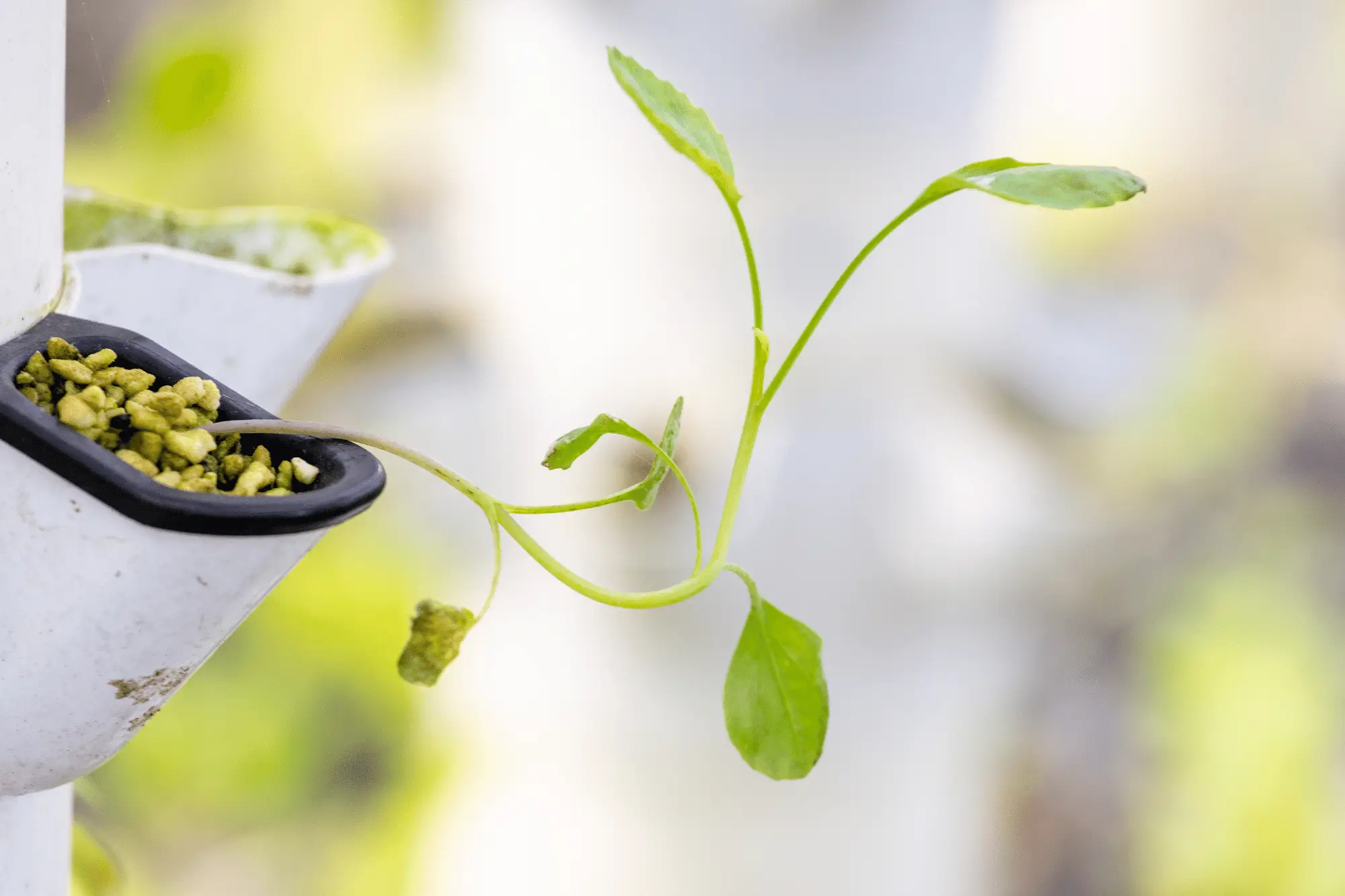Imagine stepping just a few blocks from your home to pick up freshly harvested vegetables grown right in your neighborhood. This is the reality that container farming is creating across the country.
Using repurposed shipping containers, container farms turn underutilized spaces into agricultural hubs. The innovative approach to farming brings fresh produce closer to consumers while contributing to a sustainable city environment.
Below, we’ll cover the advantages and benefits of container farms. Then, we’ll look at how these benefits are realized in the real world.
What is Container Farming?

Container farming is an innovative approach to agriculture that repurposes shipping containers into self-contained growing spaces.
They’re equipped with all the essentials to grow crops, from indoor grow lights to irrigation systems and climate control technologies. The setup gives growers more control over the environment, making it possible to grow a variety of edible plants, from leafy greens to mushrooms and herbs.
The beauty of container farming is its simplicity and sustainability. By using hydroponics or aeroponics—systems that deliver water and nutrients directly to plant roots—these farms dramatically reduce the need for soil and water.
This method of farming boosts local food production and is easy on the environment.
Advantages of Container Farms
We’ve covered the basics. Now, let’s look at some of the benefits and advantages of container farms.
Optimal Use of Limited Space
When it comes to optimizing space, container farming is highly efficient. Considering their compact size how easily they can be moved (with a crane, for example), shipping containers can be placed in locations that traditional farming cannot reach. Rooftops, parking lots, and virtually any unused urban spaces are all fair game.
If that’s not enough, check out the numbers in the next section on sustainable resource use.
Sustatinble Resource Use
In terms of sustainability, container farms are cutting-edge. A 40-foot container farm needs as little as 5 gallons of water per day, while producing the same amount of produce as 2.5 acres of farmed land.
That might not sound like much, but consider that a container that’s 40 feet long and 8 feet wide takes up 320 square feet. An acre takes up 43,560 square feet (a builder’s acre is 40,000 square feet). Roughly 136 shipping containers fit on an acre of land.
If we do the math, that means that a shipping container produces around 320 times more produce per square foot. This could be crucial in places like Colorado, where droughts are an ongoing issue.
Controlled Environment
One main strength of container farms lies in their controlled environment, which allows for precise adjustments to temperature, humidity, and lighting. This control eliminates seasonal variability, ensuring consistent and predictable crop yields year-round.
With container farming, crops are less likely to be affected by diseases and pests common in open environments. This almost eliminates the need for chemical pesticides, while enhancing the quality of the produce and easing the burden on the environment.

Scalable Design
Container farms can be scaled up by simply adding more containers. Yep, you can stack these things. This gives us a flexible solution to increasing demand without the need for large tracts of land.
This is ideal for urban settings where expansion options are limited by building density and zoning laws. As demand grows, farmers can scale operations vertically or horizontally with minimal disruption to the existing operation.
Reduced Carbon Footprint
By growing food where people live, container farms cut down on long supply chains, dramatically reducing the carbon emissions associated with transporting food from rural to urban areas. This results in a smaller carbon footprint and leads to fresher produce on tables, enhancing both taste and nutritional value.
Boosting Food Security
When they are integrated into urban areas, container farms address critical issues of food access in cities. This is especially true in underserved neighborhoods often characterized as food deserts. These farms provide a steady supply of fresh produce, reducing dependency on imported foods, which can be susceptible to global supply chain disruptions.

Educational Benefts
Container farms can serve as dynamic educational tools that offer hands-on learning about sustainability and food systems. They can be integrated into school curriculums, community programs, and professional training modules. This can help educate a new generation about the benefits of sustainable agriculture and the importance of local food systems.
Real-World Examples of Container Farming
It’s important to look at real-world applications of container farms to demonstrate how these advantages come together in real life. Below, we look at a case study of a company based here in Colorado that’s at the head of container farming technology and innovation.
A Beau Gertz Case Study – Colorado Focus
One compamy transforming the container gardening in COlorado is named FArmBox Foods. Based in the Denver metro area, the company upcycles shipping containers into vertical hydroponic farms. Let’s take a closer look at the impact they are making in Colorado.
Challenges to Solve
In many urban areas, accessing fresh, healthy food is a significant challenge. The United States Department of Agriculture highlights that nearly 54 million Americans struggle with this issue.
Conventional agriculture consumes about half of the U.S. freshwater supply and it’s under strain from increasing droughts and complex supply chain issues (source). Here’s what FarmBox has done to address these challenges.
FarmBox Solutions
FarmBox Foods addresses these challenges by employing vertical hydroponic technology within shipping containers. This system allows for year-round crop production without soil, using significantly less water than traditional farming methods.
As we discussed above, a container can produce the equivalent of up to 2.5 acres of farmland each year, using a fraction of the water and space
Community and Environmental Impact
The hydroponic containers from FarmBox use a closed-loop water system that minimizes water usage and prevents groundwater contamination. They also have a controlled environment inside that eliminates the need for pesticides and herbicides. The environmental impact is pretty low.
FarmBox is solving food access issues and also supporting local economies. Their model promotes farm-to-table supply chains which reduces emissions and ensures fresh produce is available to local communities.
Food for Food – Optimizing Resource Use for Livestock Feed
Not only is FarmBox Foods directly improving plant-based food accessibility for humans, but through innovation, it has a method for reducing the environmental impact of animal husbandry.
It takes an alarming quantity of resources to raise a single beef cow. Let’s break it down quickly.
Beyond Feeding Communities — Innovative Uses
FarmBox Foods is also innovating in the space. After identifying a common challenge faced by livestock farmers, it came up with a brilliant idea: use container farming to provide feed for livestock! Let’s use beef cows as an example.
Consider this:
Traditional Farming of Livestock Fodder
- The average beef cow consumes ~ 25 pounds (11.3 kilos) of feed per day
- Cows are normally slaughtered for processing between 22 and 24 months
- Using the high end of that range, 24 months span 730 days
- 25 pounds of feed for 730 days equals
- That’s around 18,250 pounds (or roughly 9 tons) of feed to raise one beef cow
- It requires between 264,000 and 528,000 gallons of water to produce one ton of cow feed using traditional farming methods
- That’s between 2.3M and 4.8M gallons of water throughout one cow’s lifetime
Container Farming of Livetock Fodder
- FarmBox Foods’s container farms can produce as much as three tons of barley fodder each week
- Including planting and harvesting, it takes, on average, around three months to produce a crop of barley fodder
- Plus, traditional farming is limited to a defined growing season and incurs additional costs involved in the transportation of fodder to livestock farms. This places strain on the environment due to emissions stemming from transportation
- All in all, container farms can produce the sme amount of barley fodder for livestock in three weeks (4 to 5 times faster than traditional methods)
- Finally, livestock farmers can set up a container farm next to livestock pens, eliminating transportation costs, reducing resource and land use, all of which reduce the environmental impact and associated costs.
Check out this video from FarmBox Foods to see the process in action.
Farm Backyard-to-Table
Restaurants and local food services can source premium quality vegetables and herbs directly from these hydroponic farms and offer a fresher and more sustainable menu.
FarmBox and BeatBox Farms [Denver Focus]
A great example of their technology in use is BeatBox Farms, an initiative by the Denver-based restaurant group Edible Beats.
BeatBox Farms has installed a FarmBox container in the backyard of Vital Root, a Denver-based, health-conscious restaurant. The container uses vertical hydroponic systems to supply fresh produce directly to the restaurant’s kitchen.
This integration supports the restaurant group’s goal of sourcing over 50% of its ingredients locally to reduce its carbon footprint and increase food freshness.
The 320-square-foot farm grows a variety of produce including Red Russian Kale, Runaway Arugula, Wasabina Mustard Greens, and more (the container can technically grow over 7,000 edible plants).
In total, this container farm produces 120 lbs of vegetables and greens each week. Yeah, that’s a lot. BeatBox Farms is a perfect example of what’s possible with container farms.
BeatBox is just one of the producers FarmBox Foods has equipped with this technology. It’s easy to see the impact FarBox Foods is having across the country (learn more about their work).
Conclusion
Container farming is more than just an innovative agricultural practice. It’s a sustainable boom for food production that addresses many of today’s community challenges. By transforming underused spaces into agricultural sites, these farms bring fresh produce directly to the city’s doorstep.
They reduce transportation emissions and enhance local food security. With their water and space efficiency, container farms are a resilient food source. Plus, they foster community engagement and education, turning residents into active participants in their own food production.
As cities continue to grow and farmland becomes increasingly scarce, container farming stands out as a key solution for a sustainable, food-secure future. If we embrace this model, we can reimagine where we grow and how we think about food in our communities.


